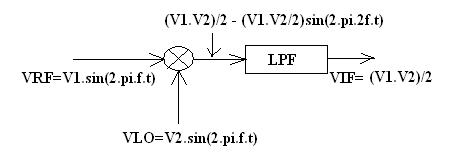shahriar22nd
Member level 2
- Joined
- Sep 24, 2009
- Messages
- 45
- Helped
- 0
- Reputation
- 0
- Reaction score
- 0
- Trophy points
- 1,286
- Location
- Dhaka, Bangladesh
- Activity points
- 1,663
Hello all,
I have a misgiving about the voltage conversion gain of mixers, That is defined as VIF/VRF, where VIF and VRF are the input and the output voltages of the (downconversion) mixer respectively. My question is- why this definition do not include VLO (the other input of the mixer)? Let me exemplify: in the ideal mixer attached herewith, VRF=V1.sin(2.pi.f.t), VLO=V2.sin(2.pi.f.t) and VIF=(V1.V2)/2 if the gains of both the mixer and the filter are 1.

So, the conversion gain would be more palpable if CG= VIF/(V1.V2/2)=1 instead of VIF/V1=V2/2 i.e. if V1=V2=10mV, then CG=1 Vs .005. This seems perplexing to me.
Can anyone please tell me what am I missing here?
Thanks and Regards ...
I have a misgiving about the voltage conversion gain of mixers, That is defined as VIF/VRF, where VIF and VRF are the input and the output voltages of the (downconversion) mixer respectively. My question is- why this definition do not include VLO (the other input of the mixer)? Let me exemplify: in the ideal mixer attached herewith, VRF=V1.sin(2.pi.f.t), VLO=V2.sin(2.pi.f.t) and VIF=(V1.V2)/2 if the gains of both the mixer and the filter are 1.

So, the conversion gain would be more palpable if CG= VIF/(V1.V2/2)=1 instead of VIF/V1=V2/2 i.e. if V1=V2=10mV, then CG=1 Vs .005. This seems perplexing to me.
Can anyone please tell me what am I missing here?
Thanks and Regards ...